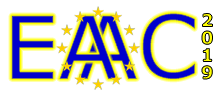Speaker
Description
The FEL beam conditioning has been proposed 30 years ago as a method to mitigate an excessive electron beam emittance, which at that time was considered the principal limiting factors for the SASE FEL development at short wavelengths. In essence, the beam conditioning implies artificially inducing at the undulator entrance a correlation in the electrons’ energies and intra-undulator betatron oscillations amplitudes. In the ideally conditioned beam, the off-axis electrons undergoing larger amplitude betatron oscillations are also faster, and thus on average better phase-matched to the slower on-axis electrons, resulting in an overall FEL gain length reduction, and improved performance. We propose to use this approach to mitigate the characteristically large output energy spreads in the laser-plasma or wakefield accelerators, and thus enable their use as drivers for FEL applications. In this case, we will use the matching section after the plasma exit to induce artificially the transverse distribution at the FEL entrance, such that places faster electrons further away from the axis, and slower electrons closer to the axis, improving the FEL gain. In this paper we illustrate this effect with the numerical models and discuss wavelength scaling and the applicability limits of the proposed approach.

